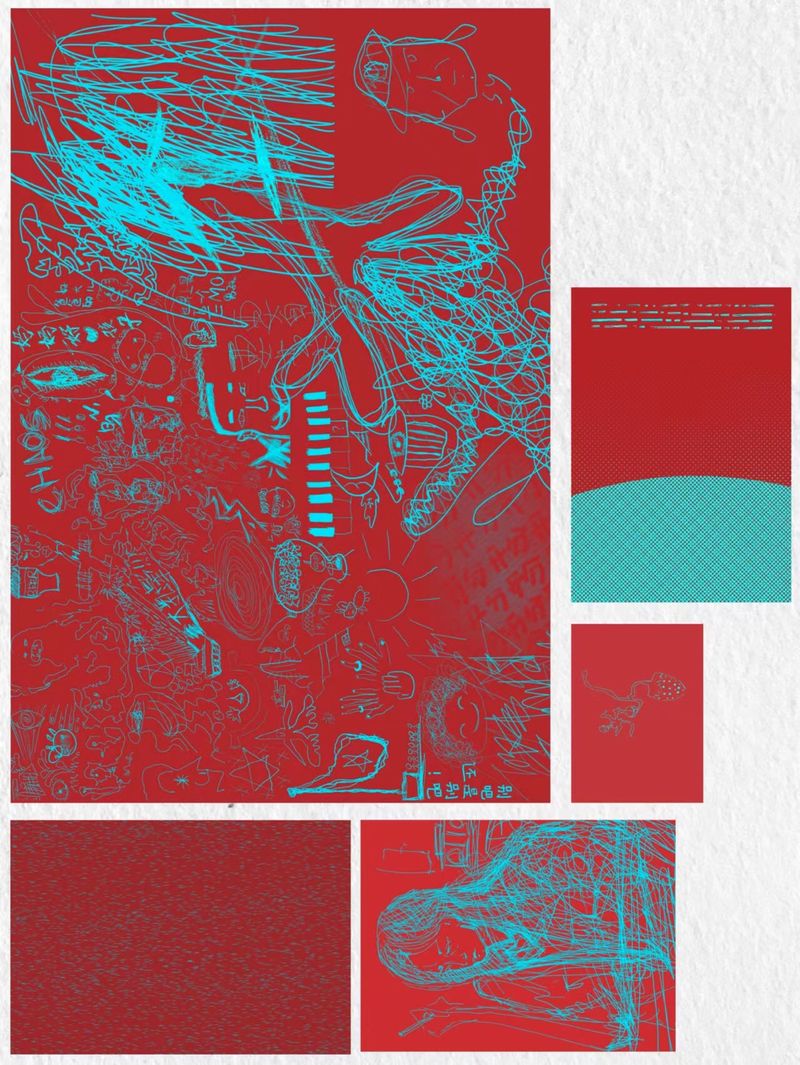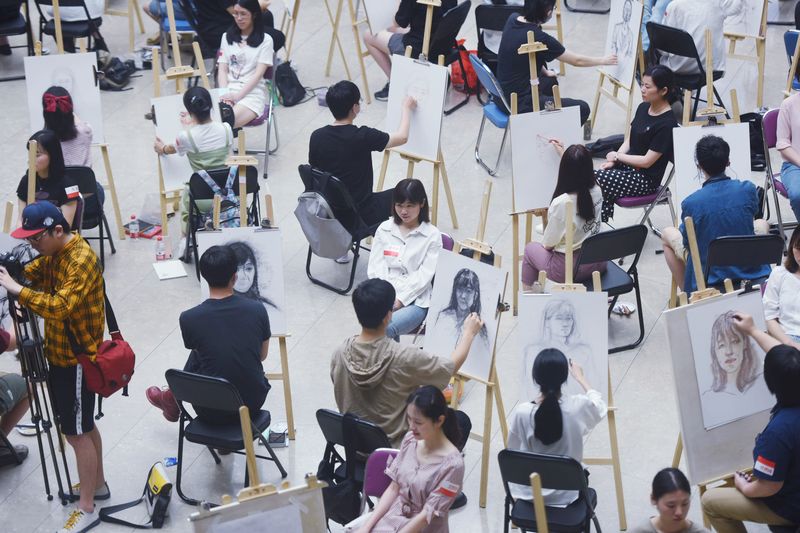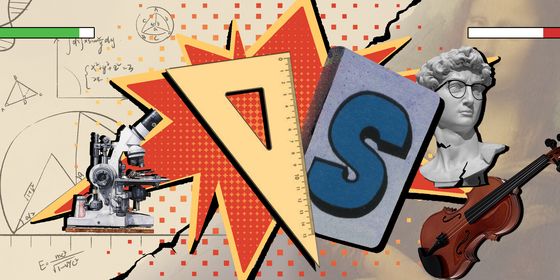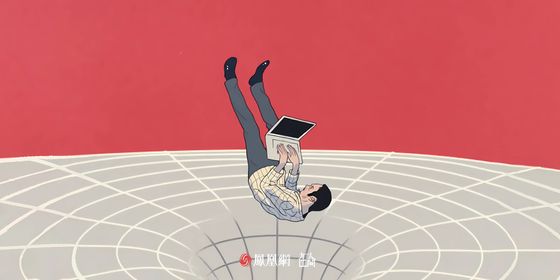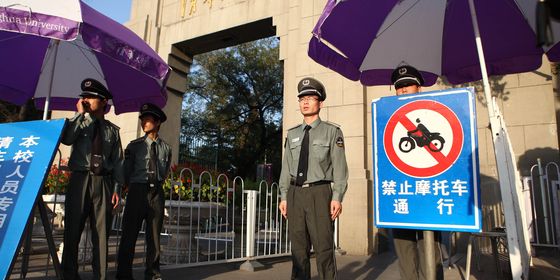Crowded enrollment, uneven teaching, and even censorship of projects are making some art students in China question the value of their degrees
When printmaking student Lu Xiaoyang began preparing his graduation project in August last year, he planned to exhibit a piece about marginalized youth, but then his university stepped in.
First, Lu’s supervisor at the Lu Xun Academy of Fine Arts in Shenyang, Liaoning province, rejected a series of his prints because of nudity in their content, and because their title, “Manchurian Gothic,” was deemed politically sensitive. Lu then submitted a new piece, “Young Kids in the Shell,” about teenagers who fall into drinking and taking drugs.
But when he viewed his university’s graduation exhibition online, Lu found his piece had inexplicably been renamed “Degeneration No. 2.” The exhibition was “meaningless to me,” Lu, who wanted to be known by a pseudonym, tells TWOC, “I was numb by the end.”
Adhering to the whims of supervisors and politically sensitive universities is just one of the challenges China’s creative art majors face during graduation season and beyond. Once considered an easy route to university for those who wanted to avoid the grueling college entrance examinations (gaokao), art majors are now increasingly competitive to enter, offer fewer job prospects, and face scrutiny for failing to adequately prepare students for jobs in art-related fields. Now, with graduate unemployment ballooning (youth unemployment hit 19.9 percent in July), art students face more uncertain prospects than ever before.
According to the Ministry of Education, of all the 10.7 million students who participated the National College Entrance Examination (gaokao) in 2020, 10.92 percent of them were aiming for creative art-related studies such as the fine arts, music, acting, and design—a total of nearly 1.2 million students. According to Yikaojie, a social media account focusing on creative arts examinations, this was an increase of 300 percent from the 320,000 students who tested in art majors in 2002. Meanwhile, higher education schools offering art-related majors had grown from 597 to about 2,000 over the same 18-year period.
Despite the competition, these majors remain popular, a fact that many students attribute to wishing to get a leg up in the gaokao. “Most people think that if they can’t get into college through the regular examination, they will at least get to continue their studies if they do art,” claims Ma Limu (pseudonym) a junior majoring in art education at a university in Guangdong province.
Applicants for art majors need to complete both the gaokao and the yikao, or the Joint Artistic Examination, which typically takes place each year in the winter. Generally, applicants for art-related subjects only need to score 50 to 70 percent of the academic grades on the national examination as certain proportion of their final score; the rest is made up from their art grades.

Examiners judging over 20,000 students' works during the entrance examination at China Academy of Art (VCG)
The art component is paint by numbers stuff, according to Ma: “There are three parts [in the fine arts examination]: sketching, charcoal drawing, and color. Tutoring organizations have guidebooks and specific instructions; you just have to follow them and you will get the grades.”
Yu Chenxing, a teacher of sculpture at China Academy of Art (CAA) in Hangzhou, Zhejiang province, believes many students go after art majors because the Chinese education system is too “purpose-oriented,” and when the students do poorly in academics, art-oriented programs are considered a shortcut for those who still want to go to universities. A university degree, increasingly, is a prerequisite for those wishing to get a well-paying job.
However, Yu, who teaches at one of the most prestigious art schools in China, believes art students shouldn’t be labeled as being academic slackers, and “lots of people are actually gifted in art; their talents have just caused them to drift away from the measurement standards in the academic system.”
For the country’s most prestigious art schools, admission is still highly competitive. In addition to art majors at regular universities (like Ma), there are specialized art academies, like CAA, that exclusively teach art-related subjects. These academies require additional tests to enter. According to the state news agency Xinhua, applications for Beijing’s Central Academy of Fine Arts (CAFA) increased from 25,000 in 2016 to over 40,000 in 2019, resulting in an acceptance rate of only 2 percent. CAA expected to enroll 1,621 undergraduates in 2018, but received 78,000 applications.
In the past, the best art schools were even more elite. Teacher Yu remembers that when he enrolled as a sculpting major at CAA in 1992, there were only six people on his course, and a dozen teachers available to tutor them. Nowadays, the same major enrolls about 30 to 40 students each year, but the number of instructors hasn’t changed.
Even a degree from these prestigious institutions, though, does not guarantee satisfactory employment later, and it’s certainly no guarantee of becoming a professional artist. A report by News Express in 2020 found that over 48 percent of graduates from CAFA that year ended up in jobs in the education industry, many of them art teachers; while 23 percent gained employment in the culture, sports, and entertainment industries.
“People don’t know what to do in their professions. When some prepare to be professional artists after graduation, they would only start learning how to make a living from it [after graduating],” an incoming senior at the Tianjin Academy of Fine Arts who asked to use only his surname, Du, tells TWOC.
Du says that during the last three years of his studies, he has never been introduced to practical concepts like the role of art curators or how to send portfolios to art galleries. He contrasts this to art programs in other countries, which he argues have far more specific courses and modules on these practical matters.
“We were just [taught to do] some polishing on molds so that you have solid basic skills,” Lu echoes of his printmaking major, saying he didn’t learn much about other skills required to become a professional artist. Both students also believe China’s art industry lacks transparency, and that the professional art “community (圈子),” consisting of full-time artists who make profitable sales and get to exhibit regularly, is filled with older or well-connected artists, and is difficult to break into as a newcomer.
More widely, art students often suffer stigma from employers (in part because they are considered not smart enough for the regular gaokao), while some online have disparaged their artistic skills. Similar to a thesis defense in academic majors, graduation exhibitions are usually the final step in art programs before students are awarded their diplomas and present themselves to the art world. They are also usually open to the public (and are increasingly put online), giving universities and academies an opportunity to show off their students’ achievements.
However, graduating students, and even art academies themselves, have been frequently accused of plagiarism. In 2019, the same project, “Dunhuang Gift Tea,” was found in the graduation exhibition of the package design major at both Southwest University in Chongqing and the Sichuan Fine Arts Institute. The same year, illustrator Kuri accused the Hubei Institute of Fine Arts for plagiarized one of her illustrations in a poster advertising their animation students’ graduation exhibition. Lu claims that “lots” of his classmates use screenshots from movies or pictures from online influencers for their graduation pieces, and blames the students’ own lack of motivation and professionalism.
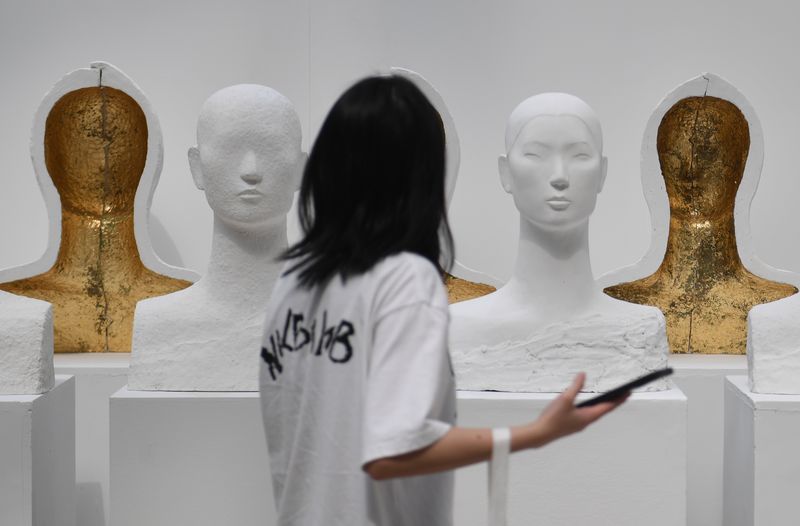
This year's graduation exhibition at China Academy of Art. Over 3,000 student works were exhibited across various disciplines (VCG)
Du still has another year to go before graduation, but he has already decided he doesn’t want to be a professional artist. “I can still do art as a hobby, but make a living by other means,” he says. He is also considering taking the entrance examination for postgraduate studies to avoid a saturated job market, like most of his classmates and college graduates from other majors around the country.
As for passing his graduation exhibition, Du recently contributed to an article titled “How to Make Your Art Academy Projects Survive the Graduation Exhibition” posted by BAFA Art Gallery, a WeChat public account run by an art-tutoring organization called the Baoan Temple Art School. Various students gave examples of censored art pieces, including those that depicted homosexuality and political themes. However, there were also more baffling decisions from teachers and universities to remove or request changes to pieces that represented death, and one work that featured a vast expanse of the color red.
Du is clear-eyed about the boundaries of graduation exhibitions “I’m not happy about it…[but] we know how things are, so I just have to deal with it,” he says. And anyway, the exhibition is just the first hurdle in a long road for creative art graduates in the country.







